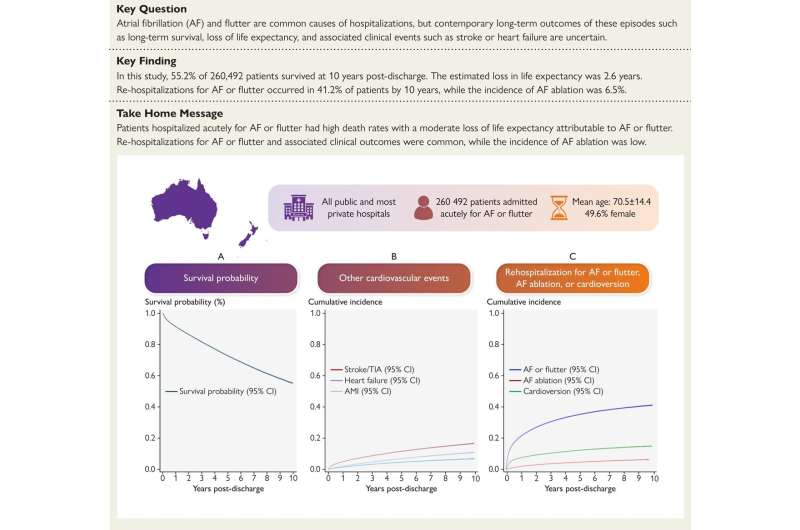This article has been reviewed according to Science X's editorial process and policies. Editors have highlighted the following attributes while ensuring the content's credibility:
fact-checked
peer-reviewed publication
trusted source
proofread
Almost half of people with common heart arrhythmia die within ten years of hospitalization, study finds

Of patients admitted to hospital for atrial fibrillation (AF) in Australia and New Zealand, 45% die within a decade, according to University of Queensland research.
A team led by Dr. Linh Ngo from UQ's Faculty of Medicine analyzed data from more than 250,000 patients admitted for AF and atrial flutter—a closely related condition—to all public and most private hospitals in Australia and New Zealand between 2008 and 2017.
The results are published in European Heart Journal.
"AF is the most common heart rhythm disorder and the leading cause of heart-related hospitalizations globally, causing symptoms like palpitations, dizziness, and chest pain," Dr. Ngo said.
"The disorder is closely associated with stroke, but we know much less about the risk of recurrent hospitalizations and other consequences such as heart failure or death.
"Unfortunately, we found only 55.2% of patients hospitalized with atrial fibrillation survived beyond a decade."
Dr. Ngo said while some of those deaths were attributable to co-existing conditions, the research showed AF reduced a patient's life expectancy on average by 2.6 years.
"At 10 years, 1 in 10 patients had suffered a stroke, 1 in 6 were hospitalized for heart failure, and 41.2% had been readmitted due to recurrent atrial fibrillation or flutter," she said.
Co-author and cardiologist Associate Professor Isuru Ranasinghe from the Prince Charles Hospital said the research revealed at 10 years, less than 7% of patients had catheter ablation procedure, one of the most effective treatments for patients with symptomatic atrial fibrillation.
"It may mean this procedure was underused in Australian and New Zealand hospitals," Dr. Ranasinghe said.
"Clinicians currently primarily focus on preventing the risk of stroke, but these findings emphasize the need to consider atrial fibrillation as a chronic disease with multiple serious downstream consequences.
"There needs to be a greater focus on preventing recurrent hospitalizations and heart failure.
"The literature also suggests many patients at high risk of a stroke fail to receive blood thinning medications, so current preventative efforts are far from ideal.
"Better patient education in areas such as blood pressure control and weight loss, as well as appropriate preventative therapy in hospital and primary care could improve the outcomes for people with AF."
More information: Linh Thi Hai Ngo et al, Long-term outcomes after hospitalization for atrial fibrillation or flutter, European Heart Journal (2024). DOI: 10.1093/eurheartj/ehae204





















